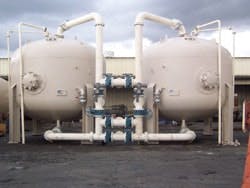Teamwork Rids Southern California City of Arsenic Problem
| Related Searches from WaterInfoLink.com Arsenic Removal | Loma Linda | Lockheed Martin | Severn Trent Services |
On May 13, 2008, a partnership between the city of Loma Linda, Calif., and one of its leading corporate citizens took the next step in an 11-year process to improve the local water system. That’s when Lockheed Martin, one of the world’s leading aerospace companies, transferred ownership and operations of an arsenic removal facility it had built to the city.
The facility was designed and constructed in 2006 to remove naturally occurring arsenic levels in Loma Linda’s groundwater to meet stringent U.S. Environmental Protection Agency (EPA) arsenic level requirements of 10 parts per billion (ppb). Before construction, arsenic levels in two water system wells ranged from 18 to 22 ppb.
“Our goal is to provide Loma Linda with the safest water. Therefore, we knew this facility was a step forward in continuing to provide local residents with the highest quality of water,” said Brad Owens, director of environmental remediation for Lockheed Martin. “We are dedicated to our partnership with the city of Loma Linda and these improvements. It’s something that is very important to us.”
Earth Tech AECOM, a provider of engineering, construction and operations services to the water and wastewater industry, was hired to select the most suitable arsenic treatment system. Pacific Hydratech, a company that provides construction services for the water and oil refining industries, served as the project’s general contractor.
Earth Tech AECOM evaluated a number of arsenic removal technologies and eliminated many of them from consideration because they lacked demonstrated ability to meet the target arsenic removal. These technologies included microfiltration, ultrafiltration, nanofiltration, permeable reactive barriers, electrokinetic, phytoremediation and biological treatment. Reverse osmosis and electrodialysis reversal were rejected based on high cost and complications associated with residuals disposal. The precipitative processes were also eliminated because of multiple chemical requirements, significant volumes of sludge processing and skilled operator attention needed for proper operation.
After the initial screening, ion exchange and adsorptive processes were selected for detailed evaluation. Two systems, one each from the ion exchange and adsorptive processes, were established as preferred systems, and proposals were requested for each technology.
In the end, the SORB 33 arsenic removal technology and Bayoxide E33 arsenic removal media were selected for the project.
Severn Trent Services developed the SORB 33 process to reduce arsenic contamination across a range of water treatment application sizes, and the technology has been commercially proven to effectively and economically meet U.S. EPA standards for maximum arsenic contaminant levels. Bayoxide E33 is a dry, robust, granular ferric oxide media designed with a high capacity for arsenic, providing long operating cycles and low operating costs.
The city’s system is designed to treat up to 3,000 gal per minute (gpm), making it one of the largest such systems in California. The system serves 21,000 residents and businesses. It consists of four carbon steel pressure adsorbers, piping, instrumentation controls and the adsorption media. The well water is fed in parallel downward flow, generally through three of the four vessels containing the media. The fourth vessel is maintained in standby. The system includes a pH adjustment unit that feeds carbon dioxide into the feedwater to reduce pH to about 8.0. The system also has a bypass control loop to flow up to 25% of the well water flow around the pH adjustment and arsenic removal adsorbers, subsequently to be blended with the treated water.
Pressure differential through each vessel is measured and used to determine when it is necessary to backwash, or “fluff,” the media. Backwashing and resting the beds periodically extends media life. Periodically, each adsorber is taken offline for backwashing to remove media fines that have built up and to fluff up the compacted bed and then rested for a few days. The backwash water is decanted and later mixed with the plant influent water.
Aside from backwashing, there are no other steps required until the end of the adsorbent’s capacity, when it becomes exhausted.
According to Steve Wood, Severn Trent Services’ arsenic regional sales manager, the system has operated as expected, reducing arsenic levels to less than the maximum contaminant level (MCL) of 10 ppb.
“The Loma Linda/Lockheed Martin partnership was very deliberate in their approach to solving the arsenic problem in Loma Linda,” he said. “They investigated more than a dozen different arsenic removal technologies and then extensively tested the adsorptive technology they selected. Over the past 11 years, the partnership has constructed one of the most robust water treatment systems I’ve seen.”
“Our partnership with Lockheed Martin has led to great improvements to our water infrastructure and improved water quality for our residents now and into the future,” said Jarb Thaipejr, public works director for the city.
